1. Introduction¶

GATE a Monte-Carlo simulation toolkit for medical physics applications
1.1. Authors¶
- OpenGATE collaboration : http://www.opengatecollaboration.org
- OpenGATE spokesperson: L. Maigne (LPC UMR 6533 CNRS/IN2P3, Clermont-Ferrand, France)
- OpenGATE technical coordinator: D. Sarrut (CREATIS UMR CNRS 5220, Lyon, France)
- Gate authors: authors
- Members of the OpenGATE Collaboration: members
- Special Thanks: Geant4 Collaboration and LOW energy WG
1.2. Forewords¶
Monte Carlo simulation is an essential tool in emission tomography to assist in the design of new medical imaging devices, assess new implementations of image reconstruction algorithms and/or scatter correction techniques, and optimise scan protocols. Although dedicated Monte Carlo codes have been developed for Positron Emission Tomography (PET) and for Single Photon Emission Computerized Tomography (SPECT), these tools suffer from a variety of drawbacks and limitations in terms of validation, accuracy, and/or support (Buvat). On the other hand, accurate and versatile simulation codes such as GEANT3 (G3), EGS4, MCNP, and GEANT4 have been written for high energy physics. They all include well-validated physics models, geometry modeling tools, and efficient visualization utilities. However these packages are quite complex and necessitate a steep learning curve.
GATE, the GEANT4 Application for Emission Tomography (MIC02, Siena02, ITBS02, GATE, encapsulates the GEANT4 libraries in order to achieve a modular, versatile, scripted simulation toolkit adapted to the field of nuclear medicine. In particular, GATE provides the capability for modeling time-dependent phenomena such as detector movements or source decay kinetics, thus allowing the simulation of time curves under realistic acquisition conditions.
GATE was developed within the OpenGATE Collaboration with the objective to provide the academic community with a free software, general-purpose, GEANT4-based simulation platform for emission tomography. The collaboration currently includes 21 laboratories fully dedicated to the task of improving, documenting, and testing GATE thoroughly against most of the imaging systems commercially available in PET and SPECT (Staelens, Lazaro).
Particular attention was paid to provide meaningful documentation with the simulation software package, including installation and user’s guides, and a list of FAQs. This will hopefully make possible the long term support and continuity of GATE, which we intend to propose as a new standard for Monte Carlo simulation in nuclear medicine.
In name of the OpenGATE Collaboration
Christian MOREL CPPM CNRS/IN2P3, Marseille, 2004
1.3. Overview¶
GATE combines the advantages of the GEANT4 simulation toolkit well-validated physics models, sophisticated geometry description, and powerful visualization and 3D rendering tools with original features specific to emission tomography. It consists of several hundred C++ classes. Mechanisms used to manage time, geometry, and radioactive sources form a core layer of C++ classes close to the GEANT4 kernel Fig. 1.2. An application layer allows for the implementation of user classes derived from the core layer classes, e.g. building specific geometrical volume shapes and/or specifying operations on these volumes like rotations or translations. Since the application layer implements all appropriate features, the use of GATE does not require C++ programming: a dedicated scripting mechanism - hereafter referred to as the macro language - that extends the native command interpreter of GEANT4 makes it possible to perform and to control Monte Carlo simulations of realistic setups.

Fig. 1.2 Structure of GATE
One of the most innovative features of GATE is its capability to synchronize all time-dependent components in order to allow a coherent description of the acquisition process. As for the geometry definition, the elements of the geometry can be set into movement via scripting. All movements of the geometrical elements are kept synchronized with the evolution of the source activities. For this purpose, the acquisition is subdivided into a number of time-steps during which the elements of the geometry are considered to be at rest. Decay times are generated within these time-steps so that the number of events decreases exponentially from time-step to time-step, and decreases also inside each time-step according to the decay kinetics of each radioisotope. This allows for the modeling of time-dependent processes such as count rates, random coincidences, or detector dead-time on an event-by-event basis. Moreover, the GEANT4 interaction histories can be used to mimic realistic detector output. In GATE, detector electronic response is modeled as a linear processing chain designed by the user to reproduce e.g. the detector cross-talk, its energy resolution, or its trigger efficiency.
The first users guide was organized as follow: chapter 1 of this document guides you to get started with GATE. The macro language is detailed in Chapter 2. Visualisation tools are described in Chapter 3. Then, Chapter 4 illustrates how to define a geometry by using the macro language, Chapter 5 how to define a system, Chapter 6 how to attach sensitive detectors, and Chapter 7 how to set up the physics used for the simulation. Chapter 8 discusses the different radioactive source definitions. Chapter 9 introduces the digitizer which allows you to tune your simulation to the very experimental parameters of your setup. Chapter 10 draws the architecture of a simulation. Data output are described in Chapter 11. Finally, Chapter 12 gives the principal material definitions available in GATE. Chapter 13 illustrates the interactive, bathc, or cluster modes of running GATE.